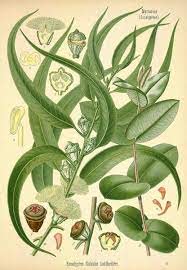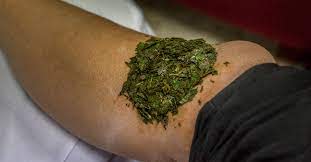Since it is included in so many medicinal preparations, the aroma of eucalyptus is recognised by almost everyone. Native to Australia, there are over 600 species of eucalyptus which are now cultivated throughout the world.

While some species are shrubs, others are trees of immense size and beauty. In their country of origin, they often attain a height of 100m or more - a few are even taller than the famous giant redwoods of California. The trees provide food for the koala bear, which feeds exclusively on eucalyptus leaves.
The Fever Tree
Not all species of eucalyptus, however, produce an essential oil. The Tasmanian blue gum (Eucalyptus globulus), called ballook by the Australian aboriginals, is widely cultivated around the Mediterranean and is the favoured variety for medicinal purposes. The flower buds are covered by an extraordinary cap-like membrane, which pops open like a lid when ready for pollination, revealing the small, fragrant, white blooms. The bark occasionally exudes a sweet-smelling gum, though only the bluish-green leathery leaves produce the essential oil. The numerous oil glands are visible when a leaf is held up to the light. Other species producing useful essential oils include: narrow-leaved eucalyptus (Eucalyptus radiata) - believed to be particularly helpful for viral infections; and lemon-scented eucalyptus (Eucalyptus citriadora) - especially recommended for rheumatic aches and pains.
In the 19th century, the 'fever tree' (as it became known) was often planted in unhealthy marshy and malarial districts, such as Campagna, near Rome. The huge, strong roots are capable of absorbing enormous amounts of water, eventually transforming the marsh into dry land.

Eucalyptus was first used as a medicine by the aboriginal peoples of Australia. They boiled the leaves in water and took the resulting brew as a medicine to quell fevers, such as malaria.
They also used poultices made with the leaves to heal infected wounds. At one time, the European settlers in Australia smoked the dried leaves like tobacco to treat asthma.
The earliest medical research into the properties of eucalyptus leaves was carried out in Germany by Doctor Cloez (1870), Faust and Homeyer (1874). They prescribed eucalyptus for bronchitis, asthma, catarrh, coughs, colds and flu because it seemed to have a special affinity with the respiratory system. According to the 20th century aromatherapy pioneer Dr Jean Valnet, tea made from eucalyptus leaves (not the essential oil) can also lower high blood sugar levels. He suggested that eucalyptus tea may therefore help non-insulin dependent diabetes - the type which tends to occur in mid-to-late life. Treatment of such conditions, however, should be carried out only under the supervision of a qualified herbal medicinal practitioner.
Capturing the Essence
The distillation of eucalyptus began in Australia in 1854, although today most of the essential oil is produced in Spain and Portugal, as well as Brazil, California, Russia and China. The oil is captured by steam distillation of the fresh (or partially dried) leaves and young twigs. It is a virtually colourless liquid, which becomes yellow as it ages, and has a piercing camphoraceous aroma with a woody undertone. Its odour effect is usually perceived as enlivening, cooling and head-clearing.
Commercially, eucalyptus oil is used in the preparation of liniments, inhalants, cough syrups, antiseptic ointments and toothpastes. It is also used in veterinary practice and dentistry. Although little used in perfumery, eucalyptus is often found as a fragrance component in soaps, detergents and toiletries. Herbal practitioners still prescribe eucalyptus leaf tea for breathing ailments, but the essential oil has a more potent effect on the respiratory syste,. Its principle constituent, cineol, comprises 70-85% of the oil and is believed to account for its powerful germicidal action. However, Dr Valnet pointed out that the bacterial effect of cineol in isolation is less potent than the action of whole eucalyptus oil, with its other constituents acting in concert with cineol.
Therapeutic Properties
Eucalyptus oil is best known as a decongestant inhalation for chesty coughs, colds and catarrh. At the onset of cold or flu symptoms, inhaling a few drops from a bowl of steaming water throughout the day can stop the virus in its tracks.

This is less effective if carried out once the virus has taken a strong hold, although it will clear the nasal passages and sinuses temporarily, and help protect against secondary bacterial infections like bronchitis. For a sore throat, gargle with 1 or 2 drops of eucalyptus oil in warm water.
Used directly, eucalyptus is a good antiseptic for wounds and has been used successfully to treat cold sores. It helps relieve pain and itching when applied to the blisters of shingles, and is a good choice in a massage blend for easing rheumatic pain and fibrositis.
Eucalyptus effectively repels or kills insects, and for this purpose may be applied diluted to the skin, or used in burners and sprays. It can be helpful for blemished skin, greasy hair and dandruff, where it could be blended with a sweeter-smelling and therapeutically compatible oil, such as lavender.
The cooling and penetrating qualities of eucalyptus promote easier mental concentration and logical thought processes, so it is good to use in a burner for study purposes.